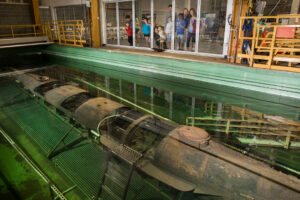Hunley’s Overhead Truss Removed: The Legendary Submarine Now Fully Visible for First Time Since 1864
For more information contact: For Immediate Release:
Kellen Correia at 843.743.4865, x.32 January 12th, 2012
Seeing the Hunley has never been easy. For over a century, the submarine was hidden by the depths of the sea. Since the Hunley was recovered in 2000, she has been obscured by a steel truss mega-structure that was used to lift her from the ocean. Today, that changed and the Hunley is completely visible for the first time since 1864.
The 50-foot, 17,000-pound truss that has long been a view-blocking appendage sitting on top of the Hunley was carefully removed by experts in what was at times a delicate procedure. Though necessary for the Hunley’s safety, the truss has also completely obstructed a full viewing of the submarine until now.
Enhancing the visitor experience is only one of the benefits of today’s big move. “Separating the truss from the Hunley represents the official beginning of the final conservation treatment of the Hunley,” said Mike Drews, Director of Clemson’s Warren Lasch Conservation Center, home to the legendary submarine and other significant pieces of American history.
Next, modifications will begin on the Hunley’s 90,000-gallon conservation tank. The tank, which currently holds chilled fresh water to stabilize the submarine as she awaits treatment, needs to be altered in order to accommodate the chemicals necessary for conservation.
Scientists hope to have the submarine soaking in the chemical bath by the end of this year. The solution is designed to slowly leach out the salts that infiltrated the Hunley’s iron during her 136-year stay on the ocean floor. Those salts are toxic to iron and threaten the very survival of the world’s first successful combat’s submarine.
After several months of soaking in the solution, the layer of concreted sand, shell, and silt that encases the Hunley will be carefully removed, allowing for a faster pace of conservation.
Though it is no longer needed to support the Hunley, the steel truss will continue to have a role in the Project. It will be stored and used in the future museum display of the Hunley. “The large steel structure was an integral part of the cutting edge technological achievement in the Hunley’s recovery. It will be preserved and placed in the planned Hunley Museum to tell future generations about the technology that encompassed every aspect of the Hunley story from the submarine itself, to its recovery, and to its conservation and preservation,” said Senator Glenn McConnell, Chairman of the Hunley Commission.
The Hunley Project
On the evening of February 17, 1864, the H. L. Hunley became the world’s first successful combat submarine by sinking the USS Housatonic. After signaling to shore that the mission had been accomplished, the submarine and her crew of eight mysteriously vanished. Lost at sea for over a century, the Hunley was located in 1995 by Clive Cussler’s National Underwater and Marine Agency (NUMA). The innovative hand-cranked vessel was raised in 2000 and delivered to the Warren Lasch Conservation Center, where an international team of scientists are at work to conserve the submarine for future generations and piece together clues to solve the mystery of her disappearance. The Hunley Project is conducted through a partnership with the Clemson University Restoration Institute, South Carolina Hunley Commission, Naval Historical Center, and Friends of the Hunley.



